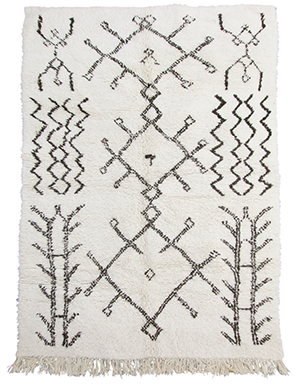The Moroccan Rug - The Handwoven Berber Rug
Posted by The London Cows Team on 30th Sep 2016
The History of Moroccan Rugs

Most people think of art in terms of paintings or sculptures that only
exist to look beautiful, but that's a relatively modern innovation.
Historically, most art took the form of decorations on useful objects.
Textile art was especially common, and rugs were one of the most popular
forms. That ancient tradition of textile art still survives with the
traditional Moroccan rugs that are woven by the Berber people in the
modern day.
What Do They Look Like?
A Berber rug can be distinguished from other carpets by their
distinctive knot, which is unique to the region. Like most traditional
crafts, they tend to feature relatively simple geometric patterns as
decorations, many of which are culturally significant to the people of
Morocco. It is rare for a single rug to use more than a couple of colours
in its design, which gives them a simple and understated elegance that
is rare in mass-produced goods.
How Are They Made?
Imitation Moroccan Rugs are often produced with machines in factories,
but the genuine article is still made by hand with traditional methods. A Berber rug begins as a pile of wool that is carded and spun.
Traditional weavers insist that this wool is sheared from a live sheep
rather than from a sheepskin. The sheep naturally produce both dark and
light wool, which allows Berber artisans to create patterned rugs
without adding artificial dyes should they wish to do so. Some artisans
do prefer to dye their wool, but many others rely on the wool's natural
colours. The use of natural colours is particularly common among the Beni
Ourain people, whose traditional patterns and motifs have become some of
the most popular among Moroccan weavers.
The wool then goes to the weaver, who creates the carpet by hand. The
artisans rely on traditional knotting techniques to create the carpets.
Those techniques give the carpets their characteristic appearance,
texture, and durability. Historically, many homes produced their own
carpets for private use or for trade with outsiders, with children
learning the art from their parents. Master artisans would produce rugs
of higher quality for profit or for use as gifts to important people.
That is sometimes the case in the modern world, especially in rural
regions, but household production has long since taken a back seat in
favor of master craftsmen.
How Are They Used?
Moroccan carpets have been popular for hundreds of years. Ancient
Moroccans valued them so highly that they became one of the preferred
gifts for the upper ranks of society. They valued the rugs not only for
their beauty, but also for their practical value. The traditional
crafting methods create rugs that are very durable. That made them
especially useful for people who maintained a rugged lifestyle in the
desert, but it also makes them a decent choice for relatively high-traffic areas in
modern homes. Those traits have
ensured that they remain popular as practical decorations, just as they
have been for hundreds of years in the past.
